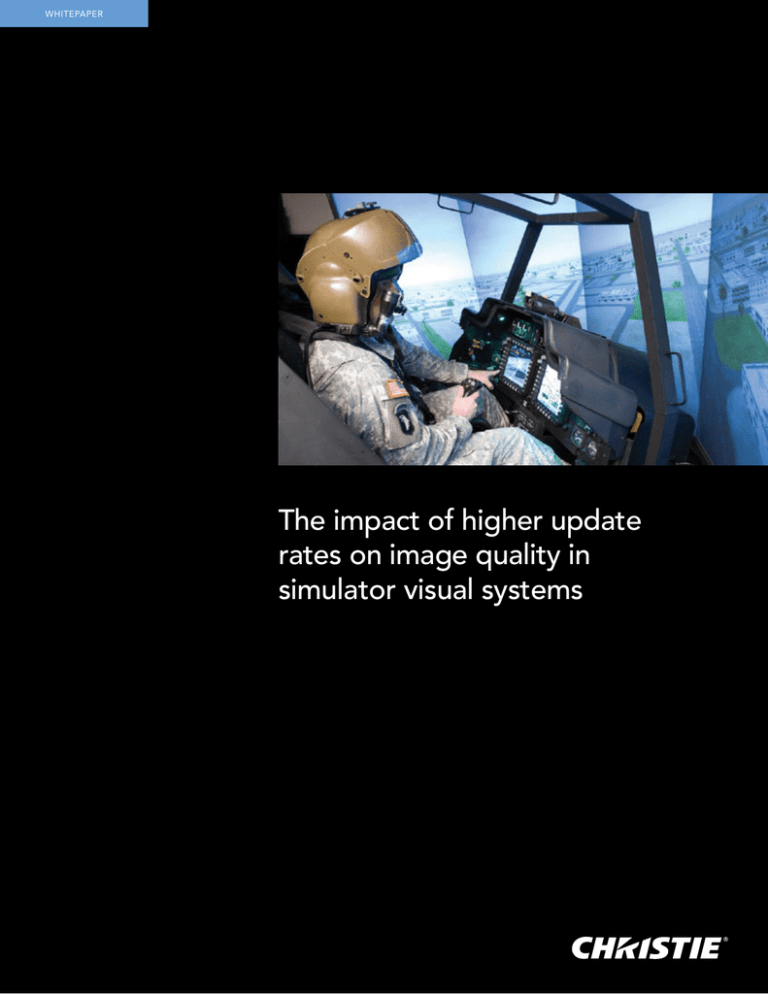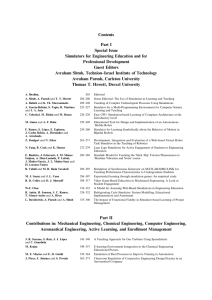
WHITEPAPER
The impact of higher update
rates on image quality in
simulator visual systems
SIMULATOR UPDATE RATES
How to reduce Motion-Induced Blur and Spatio-Temporal Aliasing
Simulator visual systems are invaluable
tools used by a variety of organizations
to streamline processes, enhance
training and develop and improve
design concepts. Representing one of
the most widely used types of simulator,
vehicle simulator systems are employed
by commercial, governmental and
Update rates in
simulator visual systems
The update rate of a visual system is
dependent on both the image generator
and the display and refers to the rate at
which new images are displayed on the
screen. The majority of the industry has
adopted 60Hz update rates as a standard
for simulation applications. However,
as technological advances have allowed
simulators to generate scenes with higher
levels of realism, resolution, database
detail, color, contrast and brightness,
it’s becoming apparent that a 60Hz update
rate is inadequate to properly generate
high-resolution dynamic imagery.
Although a simulator system running
at 60Hz update rates is satisfactory
for some simulations, as the quality,
complexity and detail of simulation
needs increase, so can the occurrence
of unwanted motion-related visual
artifacts. Two common artifacts that
occur as a result of low update rates are:
Motion-Induced Blur (MIB) and SpatioTemporal Aliasing (STA). Although MIB
and STA are different phenomena,
they both affect the dynamic image
performance and fidelity of a simulator
system. To properly address these issues
and allow simulation systems to develop
beyond the current standard, we must
be able to reduce the occurrence
of these artifacts while meeting the
brightness requirements of the display
without affecting image quality,
brightness and simulation complexity.
This can be accomplished by using
simulator visual systems capable
of producing higher update rates.
1
military organizations to provide integral
training for a variety of flight, maritime
and driving procedures.
The primary performance requirements
of any simulator visual system are that the
simulation imagery must be generated
and displayed in real-time with minimum
latency. Add to this the increasing
demands for accurate and true-to-life
simulated scenes, and what is left is an
immediate need for systems with high
processing power and high-resolution
imagery, capable of producing complex
and rich simulation environments that
react to user input quickly and accurately.
120Hz: setting the standard
Motion-Induced Blur (MIB)
To understand how a 120Hz update
rate reduces motion-related visual
artifacts, refresh rates and frame rates
must be understood.
MIB is an interaction between the user’s
eye movements and the display. It occurs
in displays featuring a long hold-time,
which is the amount of time a pixel
is illuminated relative to the display’s
refresh rate. When using a simulation
that features a long hold-time, the eye
movement of the user produces the
perception of motion-induced blur.
This results in an unnatural blurring
of the environment, compromising
the accuracy of the simulated scene.
Refresh rate: As a function of the
display, the refresh rate refers to the
rate at which an image is redrawn
on the screen/display.
Frame rate: The frame rate is the rate
at which image content is created and
is a function of the image generator.
Determining the update rate is
dependent on both the image generator
and the display and refers to the rate
at which new images are displayed on
a display screen. Therefore, a simulator
visual system operating at a 120Hz
update rate is capable of displaying
120 new images on the display screen
every second. By doubling the update
to 120Hz from 60Hz, simulation content
designers are able to create more realistic
simulation environments without worrying
about the appearance of unwanted
artifacts in the display.
Motion-related visual artifacts
The occurrence of motion-related visual
artifacts in virtual simulator systems is the
result of a variety of factors. They appear
in the display as unnatural occurrences
that wouldn’t happen in a real-life
situation, causing unwanted distraction
and a reduction in the integrity of the
simulation image. Two motion-related
visual artifacts that are a direct result of
low update rates are Motion-Induced Blur
(MIB) and Spatio-Temporal Aliasing (STA).
How it is reduced
In a 60Hz system, MIB is reduced by
decreasing the portion of the frame that
the pixels are illuminated (hold-time).
This can be accomplished several
ways, such as: a shuttering mechanism,
inserting a black frame into the color
wheel, or through light intensity
modulation. Although effective in
reducing blur, these “fixes” also reduce
the maximum display brightness potential
and increase the occurrence of flicker
artifacts. This trade-off isn’t ideal,
especially as scene complexity continues
to increase.
Higher update rates and MIB
Simulator visual systems running at
120Hz offer a solution that not only
reduces MIB, but also doesn’t compromise
the brightness of the display.
SIMULATOR UPDATE RATES
Christie Matrix Series: A system
approach to reducing artifacts
using higher update rates
Spatio-Temporal Aliasing (STA)
60Hz operation
Desired image
IG channel 1
outputs
content @ 60Hz
Smear: motion aliasing
eliminates path undulation
Projector displays
content @ 60Hz
Projector displays
content @ 60Hz
with AccuFrame
(draw time = 8.3mS)
Motion aliasing
eliminates path undulation:
brightness decreased
16.67 mS
120Hz operation
IG channel 1 outputs
content @ 60Hz
IG channel 2 outputs
content rendered
for time 8.3mS later
@ 60Hz
Projector displays
content @ 120Hz
1
2
3
8.3 mS time offset between channel 1 and channel 2
A
B
C
1
A
2
B
3
C
Higher update rate reduces
motion aliasing and smear
without loss in brightness
Simulation scenes are made up of
a series of individual images refreshed
on the display to create the appearance
of seamless movement throughout
the environment based on the input
of the user. STA causes false or poor
motion cues from the wrong direction,
or at wrong rate, instead of giving the
impression of smoothly moving visuals.
It is proportional to image motion
and frequency content (both spatial
and temporal).
How it is reduced
STA artifacts can be reduced when
the sampling rate of a scene is at least
twice as high as the fastest moving
object. As such, a system with a higher
update rate can effectively reduce the
occurrence of STA.
Higher update rates and STA
Increasing update rates improves
the perception of continuous motion,
by reducing STA artifacts.
Engineered specifically to operate
at 120Hz and meet the performance
requirements of complex simulation
and training applications, the Christie®
Matrix Series of DLP® projectors
represents the leading-edge of
simulation projection technology.
Featuring a unique dual-input
architecture, the Matrix StIM, Matrix
StIM WQ and Matrix J Series projectors
provide the ability to composite two
60Hz RGB inputs to deliver true
120Hz RGB operation. This results in
the reduction of motion-related visual
artifacts and an improved dynamic
image quality and resolution without
any perceived loss of brightness.
In addition to the performance benefits
of 120Hz operation, the Matrix Series
of projectors also come standard with
Christie AccuFrame™. Developed to
further reduce MIB caused by image
retention and eye motion, Christie
AccuFrame is fully adjustable to support
various frame rates and environments,
ensuring the preservation of high-image
fidelity and scene accuracy.
For more information about
Christie simulation solutions, visit
www.christiedigital.com/simulation120
2
Corporate offices
Worldwide offices
Christie Digital Systems USA, Inc.
USA – Cypress
ph: 714 236 8610
Australia
ph: +61 (0) 7 3624 4888
France
ph: +33 (0) 1 41 21 44 04
Republic of South Africa
ph: +27 (0)11 510 0094
Brazil
ph: +55 (11) 2548 4753
Germany
ph: +49 2161 664540
Singapore
ph: +65 6877 8737
China (Beijing)
ph: +86 10 6561 0240
India
ph: +91 (080) 6708 9999
Spain
ph: +34 91 633 9990
Independent sales
consultant offices
China (Shanghai)
ph: +86 21 6278 7708
Japan (Tokyo)
ph: 81 3 3599 7481
United Arab Emirates
ph: +971 4 3206688
Italy
ph: +39 (0) 2 9902 1161
Eastern Europe and
Russian Federation
ph: +36 (0) 1 47 48 100
Korea (Seoul)
ph: +82 2 702 1601
United Kingdom
ph: +44 (0) 118 977 8000
Christie Digital Systems Canada Inc.
Canada – Kitchener
ph: 519 744 8005
For the most current specification information, please visit www.christiedigital.com
Copyright 2014 Christie Digital Systems USA, Inc. All rights reserved. All brand names and product names are trademarks, registered trademarks
or tradenames of their respective holders. Christie Digital Systems Canada Inc.’s management system is registered to ISO 9001 and ISO 14001.
Performance specifications are typical. Due to constant research, specifications are subject to change without notice.
Printed in Canada on recycled paper. 3794 Mar 14




